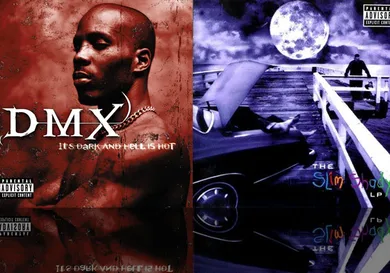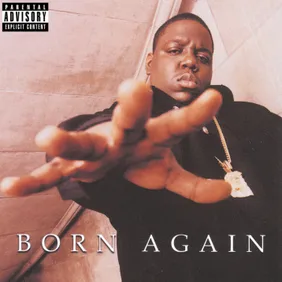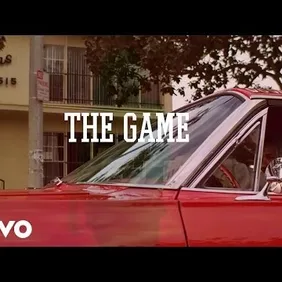On the surface, DMX and Eminem may appear to be a different breed of emcee, yet there are many similarities to be found. Insofar as commercial success, there are few who can rival the sheer magnitude of Em’s career, and while purists swear by the DIY charm of the self-released Infinite, his upward trajectory can largely be credited to his major label debut The Slim Shady LP. When that album dropped on February 23rd, 1999, Em’s infamous “hi, my name is” line skyrocketed into ubiquity. The project was devoured by mainstream media, and a co-sign from NWA legend Dr. Dre helped solidify Em’s credibility among hip-hop heads, who may have been otherwise hesitant to embrace a goofy looking whiteboy with bleach blonde hair.
While Em and Dre were busy linking up in the studio for the first time, DMX was riding the wave of his own debut album, the gothic masterpiece It’s Dark And Hell Is Hot. As fellow New York contemporaries like Jay-Z, Nas, and Busta Rhymes were in the middle of carving out their own legacies, X was looking to make his mark in the game. But there was something different about X. Jay was busy navigating the finer points of street-based entrepreneurship, while DMX was living and breathing the midnight gutter. With a raw, animalistic energy, X emerged onto the scene with as an unparalleled force, straying the line between a man of God attempting to stray the righteous path, and the devil personified, seeking pleasure in the most abhorrent and ruthless atrocities.
Both The Slim Shady LP and It’s Dark And Hell Is Hot indulge in violence, and while the former veers into cartoonish, comic-book-esque territory, the latter revels in the hopelessly macabre. Yet while some may be put off by the subject matter, the sheer level of enjoyment both men derive in exploring these darker themes are what makes both projects such compelling narratives. Even when the lyrics teeter into gratuitous territory, they are delivered with the craftsmanship of an auteur. Even the album artwork plays a pivotal role in capturing the essence of each project, promising nothing short of a twisted, and often deranged musical odyssey.
With that being said, both albums are widely hailed as classics by fans and critics alike. Nearly two decades have passed since X set it off with his debut, and in the interim, both Em and DMX have collaborated on the haunting battlecry "Go To Sleep." Both have enjoyed success on the big screen, and both have suffered through substance abuse and addiction problems. Now, with their peak musical days behind them, it seems an opportune time to examine how both debut albums have not only withstood the test of time, but also served to springboard a pair of iconic and larger than life careers.
Production
Unlike in our previous installment, which found Dr. Dre’s The Chronic going head to head with Snoop Dogg’s Doggystyle, the production on these two albums are handled by entirely different camps. The vast majority of The Slim Shady LP’s production was handled by Mark and Jeff Bass, better known as The Bass Brothers. The Bass Brothers were pivotal in shaping Eminem’s early sound, which ended up carrying over into his own production work; the duo favored slinky, minor key guitar lines and dynamic bass lines, and their work on tracks like “As The World Turns,” “Just Don’t Give A Fuck,” and “Brain Damage” are the foundation of Em’s drug-addled, mummified Slim Shady persona. And while the Bass Brothers were part of what made The Slim Shady LP so magnificent, Dr. Dre’s contributions cannot be undersold.
By now, everybody is aware of the widely circulated story of Dre and Eminem’s first studio session. In case you missed it, Dre was looking for a new breakout star, feeling the pressure from some of the higher ups of Interscope Records. In many ways, Em and Dre’s musical union felt like destiny, and together they would enjoy the mutual benefits of Em’s rising superstardom. On The Slim Shady LP, Dre contributed a mere three songs, but all three went on to become singles - “My Name Is,” “Guilty Conscience,” and “Role Models.” Dre’s production for Eminem generally hovers around the darker edge of the spectrum, and his ominous work on “Role Models” and “Guilty Conscience” foreshadow some of the later musical developments of The Marshall Mathers LP, Encore, and even Relapse.
Unlike Em, DMX didn’t have Dr. Dre in his corner. Instead, X opted for the services of PK, Swizz Beatz, and Dame Grease, who handled the bulk of the project’s production. There’s something raw about the instrumentation from front to back, with clever samples, dissonant orchestration, and melancholic chord progression. X’s world is not a happy place, and the musical backdrops are seldom comforting. The PK and Dame Grease collaboration “Stop Being Greedy” is a striking exercise in duality, where the instrumental goes back and forth between misguided hope and the hedonistic comfort of sin; in fact, “Stop Being Greedy” is one of the album’s most thematically definitive tracks, providing a tangible depiction of the conflict raging in X’s psyche.
There’s an interesting anecdote about the album’s most recognizable tracks, the Swizz Beatz classic “Ruff Ryders Anthem.” Apparently, DMX was initially hesitant to use the beat, calling it “rock and roll,” and “not hood enough.” Luckily for us, Swizz Beatz managed to convince him otherwise, and one of hip-hop’s most legendary movements was born. Plus, the track also led to DMX’s iconic “WHAT!?” ad-lib, so there’s that. And while “Ruff Ryders Anthem” is in a league of it’s own, it would be remiss to ignore one of the album’s most important moments - the Faustian narrative of “Damien.” While many, including Eminem, have explored themes of Satanic pacts and bargains, DMX’s eerie tale is backed by a string sample that would make Hitchcock proud.
Lyricism
If a discourse of hip-hop’s best lyricists is taking place, you know damn well that Eminem’s name will pop up in the conversation somewhere. While the rap game had no shortage of brilliant rhymers prior to Em’s emergence (Redman, Ghostface Killah, Nas, and Jay-Z to name a few), the Detroit rapper managed to string together sentences that only the most twisted genius minds could conceive. Take the second verse of album closer “Still Don’t Give A Fuck,” for example:
I walked into a gunfight with a knife to kill you
And cut you so fast, when your blood spilled it was still blue
I'll hang you till you dangle and chain you with both ankles
And pull you apart from both angles
I wanna crush your skull 'til your brains leaks out of your veins and bust open like broken water mains
So tell Saddam not to bother with makin' another bomb
‘Cause I'm crushin' the whole world in my palm
As far as technical ability, Em’s flow is one of the illest, bar none. But what makes his early work on SSLP so special is the unique combination of his persona; the lyrical influence of Infinite still lingered, but with it came an embracement of his anger and complete abandonment of self-censorship that would later go on to define his magnum opus, The Marshall Mathers LP.
All of Em’s sharpest attributes are on display here, from storytelling (“Brain Damage,” “As The World Turns,” “My Fault,”) to raw lyricism (“Role Models,” “Just Don’t Give A Fuck,” “Bad Meets Evil”). Yet it’s not all cartoonish violence and shocking punchlines, and at times, Eminem delivers a genuine sense of emotional depth. Songs like “If I Had” and “Rock Bottom” add a welcome layer of character development, an origin story of sorts that ground Em’s comic-book mystique through a relatable layer of humanity. Em would go on to embody the “tears of a clown” archetype, and it’s on The Slim Shady LP that we get a first taste of the true raison d’etre of Marshall Mathers.
Yet DMX is never one to be caught lackin'. While he hardly employs the same dexterous degree of clever imagery and rhymes, X is best when grounded in reality. True, fucked-up reality. When he’s painting pictures on the demonic “X Is Coming,” you can see, smell, and taste the horror through his vivid depictions of urban terror. DMX holds nothing back on this one, gleefully giving in to the darkness and uttering threats that would cause the internet to implode if uttered in 2017:
Cause I ain't knocking on the door
I'm coming in the house
And I'm gunning for your spouse, trying to send the bitch back to her maker
And if you got a daughter older then 15, I'ma rape her
Take her on the living room floor, right there in front of you
Then ask you seriously, whatchu wanna do?
Frustrating, isn't it? When they kill me, but I'ma kill you
Now watch me fuck just a little while longer, please, will you?
There’s no denying - it’s fucked up, and X’s Clockwork Orange-esque rhymes are the stuff of nightmares. Yet there’s something so evocative about these moments, which can unsettle and disrupt a listener’s comfort with such brutal efficacy. It’s almost as if you can feel X standing outside your door, long after the album has finished playing. For a song to have that effect is a testament to DMX’s unapologetic penmanship, and songs like “X Is Coming,” “Damian,” and “Look Thru My Eyes” are some of his strongest works.
Yet it’s not always so bleak. Over the course of nineteen tracks, X manages to deliver on several different fronts, from storytelling (“ATF,” “Crime Story”) to braggadocious bars (“Get At Me Dog,” “Fuckin’ Wit’ D”) and even mellowed out introspection (“I Can Feel it,” “The Convo”). Lyrically, X manages to navigate both spiritual worlds with near-equal attention, and while he clearly feels comfortable in the light, the Dark Man is far more at east upon giving into his namesake.
Impact
Looking back, both albums have earned their status as undeniable classics. DMX and Em went on to enjoy lucrative and lengthy careers, and while both had their ups and downs, their legacies were forever cemented on the day their debuts hit stores. There is, however, one key distinction that should be made here. While Eminem went on to release what many felt to be his strongest material, DMX may very well have delivered his best album first. Conceptually, X never quite came close to capturing the magic of It’s Dark And Hell Is Hot, despite following it up with the strong sophomore effort Flesh Of My Flesh, Blood Of My Blood.
Despite that, X’s project is a triumph from start to finish, and has a hell of a lot of replay value should you feel up for another journey into the inferno. As for the Slim Shady LP, the project has actually managed to age quite well, and captures an interesting transitional period between two of Em’s styles and identities. The production and lyrics are a refreshing and nostalgic examination of a rapper on the cusp of his glory days, resulting in a final product that is at once whimsical and horrifying, childlike and adult. One thing’s for sure - they don’t make them like this anymore.
So, which rapper had the better debut?
Eminem Vs DMX








